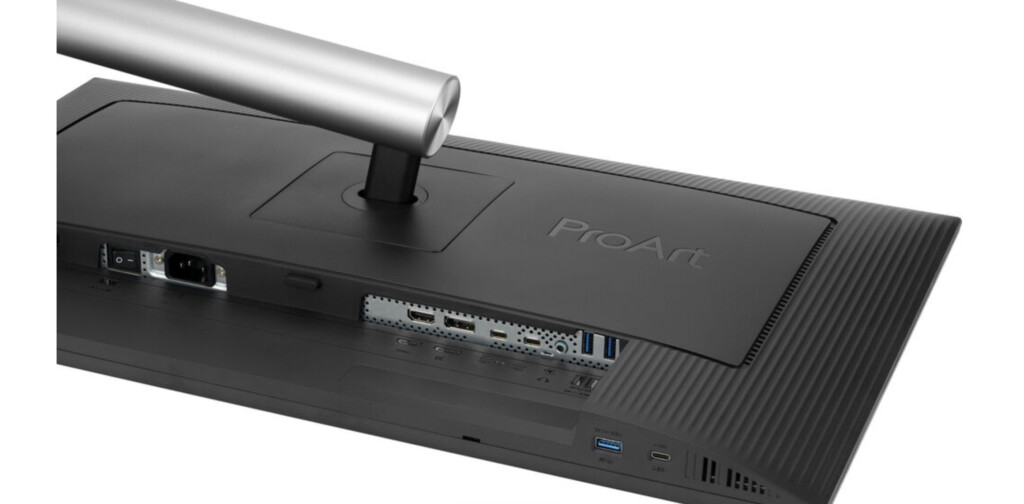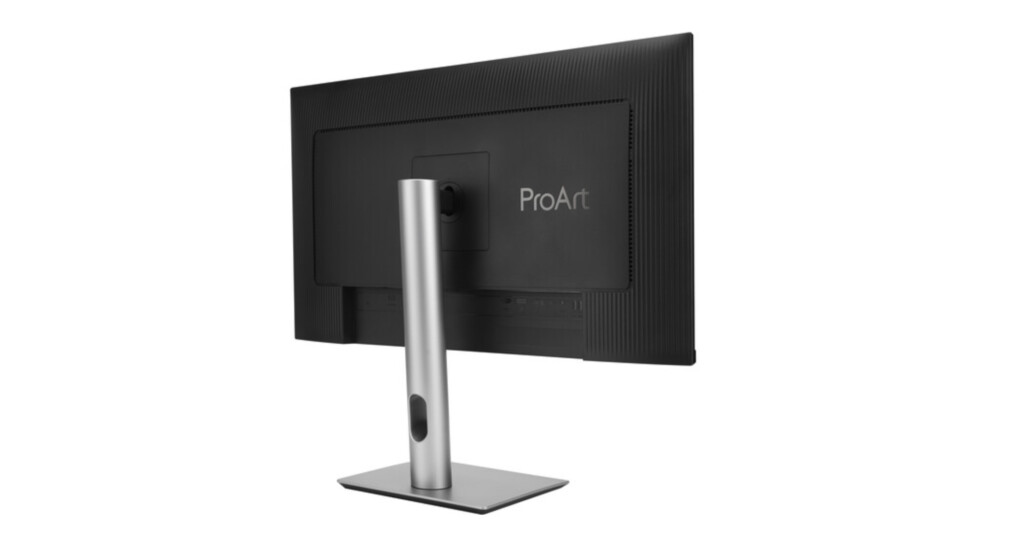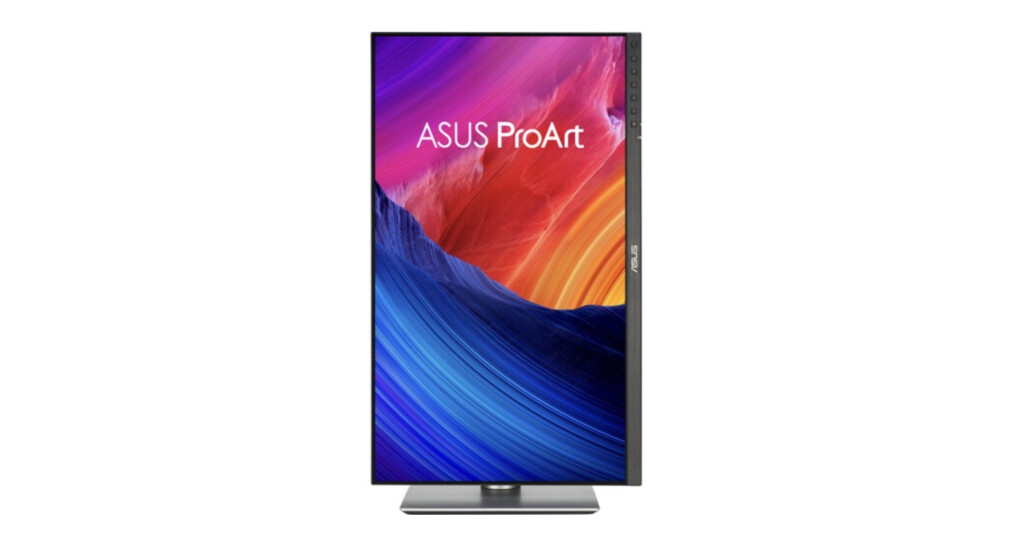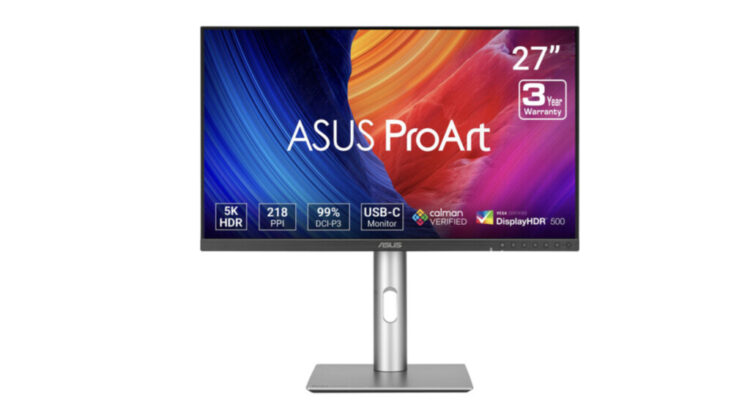At just $849, the launch of the 5K Asus Pro Art PA27JCV means the Apple Studio Display has another strong budget alternative to contend with.
The new Pro Art PA27JCV packs in a lot of Apple Studio Display features including 218 ppi, 5K resolution and incredibly high color accuracy – but for almost half the price.
Here we take an in-depth look at how the Pro Art PA27JCV compares head-to-head as one of the best alternatives to Apple’s Studio Display.
Table of Contents
Comparison Table
Firstly, here’s a side-by-side comparison of the specs of both monitors to get quick overview of how their technical specs compare.
For the purpose of the comparison, we have compared the Asus Pro Art PA27JCV with the base level Apple Studio Display with standard glass and Tilt adjustable stand.
You can also search the table if you want to compare a specific feature.
| Asus Pro Art PA27JCV | Apple Studio Display (Standard Glass, Tilt Adjustable Stand | |
|---|---|---|
| DISPLAY | ||
| Size | 27" | 27" |
| Panel Type | IPS-Type LCD | LCD |
| Aspect Ratio | 16:9 | 16:9 |
| Native Resolution | 5120 x 2880 | 5120 x 2880 |
| Maximum Brightness | 500 nits / cd/m2 (HDR Mode) | 600 nits / cd/m2 |
| HDR Support | Yes, HDR10 | No |
| Contrast Ratio | 3000:1 | - |
| Response Time | 5 ms (GtG) | - |
| Refresh Rate | 60 Hz | 60 Hz |
| Variable Refresh Technology | Adaptive-Sync | No |
| Color Support | 1.07 Billion Colors (10-Bit) | 1.07 Billion Colors (10-Bit) |
| Color Gamut | 100% sRGB 100% Rec. 709 99% DCI-P3 95% Adobe RGB | - |
| Viewing Angle (H x V) | 178 x 178° | - |
| Screen Area | 23.49 x 13.21" / 596.74 x 335.66 mm | - |
| Pixels Per Inch (ppi) | 218 ppi | 218 ppi |
| Finish | Anti-Glare / Matte | Glossy with Antireflective Coating |
| Touchscreen | No | No |
| CONNECTIVITY | ||
| Inputs | 1x DisplayPort 1.4 1x HDMI 2.1 | No |
| Outputs | 1x 1/8" / 3.5 mm (Headphone) | No |
| HDCP Supports | Yes, Version 2.2 | No |
| USB I/O | 2x USB-C 3.0 / 3.1/3.2 Gen 1 3x USB-A 3.0 / 3.1/3.2 Gen 1 | 3x USB-C 3.1/3.2 Gen 2 1x USB-C (Thunderbolt 3) |
| USB Power Delivery | 96 W (via USB-C) | 96 W (via USB-C) |
| Multi-Input Support (Picture in Picture, Multi input support) | Picture-in-Picture (PIP), Picture-by-Picture (PBP) | No |
| SPEAKER | ||
| Built-in speakers | Yes, 2x 2 W | Yes, 6 |
| HARDWARE | ||
| Processor | - | Apple A13Bionic |
| Built-in Microphone | - | Yes |
| Webcam | - | User-Facing: 12 MP |
| ELECTRICAL | ||
| Power Consumption | Typical: 26.1 W | - |
| Input Power | 100 to 240 VAC, 50 / 60 Hz | 100 to 240 VAC, 50 / 60 Hz |
| Power Adapter | Internal | - |
| GENERAL | ||
| Operating conditions | - | 50 to 95°F / 10 to 35°C at 5 to 90% Humidity |
| Certifications | ENERGY STAR, cTUVus, FCC, CEC, EPEAT | - |
| Stand Adjustments | Tilt: -5 to 23° Swivel: -30 to 30° Rotation: 90° Height: 5.1" / 130 mm | Tilt: 25° (-5 to 20°) |
| Mounting-Hole Pattern | 100 x 100 mm | 100 x 100 mm |
| Lock Slot | Yes, Kensington | No |
| Dimensions | 24.1 x 21.1 x 8.4" / 612.1 x 535.9 x 213.4 mm (with Stand) 21.1 x 14.2 x 1.7" / 535.9 x 360.7 x 43.2 mm (without Stand) | 24.5 x 18.8 x 6.6" / 62.3 x 47.8 x 16.8 cm (with Stand) |
| Weight | 13.03 lb / 5.91 kg (with Stand) 9.12 lb / 4.14 kg (without Stand) | 13.9 lb / 6.3 kg |
| PRICE | Buy Now: $849 | Buy Now: $1,599 |
Resolution and Display Quality
The ASUS ProArt PA27JCV features a 27-inch 5K resolution (5120 x 2880) display with 218 pixels per inch (ppi) – the absolute sweet spot for matching the retina displays on MacBooks.
Asus Pro Art Monitors are known for their color accuracy (other examples include the 4K Asus Pro Art PA279CV) and the color specs of the PA27JCV are some the best we’ve seen in any 5K display.
The PA27JCV is factory calibrated with support for wide color gamuts like DCI-P3, sRGB, and Rec. 709, making it ideal for detailed photo or video editing.
The Apple Studio Display, also a 27-inch 5K display (5120 x 2880) with 218 ppi is naturally designed for seamless integration with Macs.
Its strengths are an accurate P3 color space and True Tone technology, which adjusts colors based on ambient lighting.
This includes support for a staggering one billion colors.
The Studio Display is also available with a Matt panel finish which helps cut down on glare in brightly lit spaces (although this costs a few hundred dollars extra).
The PA27JCV has an “anti-glare” Matt coating although in our experience, displays that use this or so-called “anti-glare” technology are never as effective as the Matt finish on the Studio Display.
In terms of brightness, the Studio Display edges it over the PA27JCV by 100 nits but this is so negligible that you’d hardly notice it in real-life usage.
However, the most notable difference with the PA27JCV is that the Apple Studio lacks High Dynamic Rnage (HDR) support.
This may be a limitation for video editors and others who work with high dynamic range content.
There is a slight catch to be aware of though. The PA27JCV is certified to DisplayHDR 500 but that’s not quite professional grade HDR.
Nevertheless, it’s better than what you get in the Studio Display and since Netflix and other streaming sites now support HDR and Dolby Vision, the PA277JCV may be a better choice if you plan to watch a lot of videos on it.
Its rumored Apple will add HDR support in future upgrades to the Display but for now, it’s a notable feature missing.
Connectivity and Flexibility
The ASUS ProArt offers more diverse connectivity options, including HDMI, DisplayPort, and USB-C with high-wattage power delivery, making it compatible with a wide range of devices.

This flexibility is useful for users who work with multiple devices or need connectivity outside of Apple’s locked-down ecosystem.
In contrast, the Apple Studio Display is more limited in connectivity, featuring primarily Thunderbolt 3 (USB-C).
This is perfect for Mac users as all new Macs have Thundberbolt 3 or higher ports or any computer with a USB-C port.
However, in terms of connection flexibility, the PA27JCV wins out easily
Ergonomics and Build Quality
The ASUS ProArt PA27JCV has a stand with tilt, height, and swivel adjustments, which allows users to position the monitor comfortably.

You can also swivel it to use it vertically too similar to the excellent BenQ MA270U and BenQ PD3225U Mac friendly monitors.

The Apple Studio Display, while more limited in ergonomic adjustments, is available with a height-adjustable stand – but at an additional cost.
If you want a tilting, height adjustable stand it costs an extra $400/£400 extra for a VESA mount.
If you want to add Nano texture glass, you’ll need to add another $300 on top of that too.
There’s no denying though that the build quality and materials used in the Apple Studio Display are of a much higher, premium, quality than the Asus.
The glass screen and the solid metallic finish give the Studio Display a look and feel that no other monitor can compete with in our opinion.
Initial reviews of the Pro Art PA27JCV are that it does feel a bit wobbly and plasticy – especially the stand – although that seems to be par for the course for many mass produced displays these days.
Sound
There’s no competition here as you won’t find any monitor that can compete with the Apple Studio Display for sound.
The Apple Studio has four force-cancelling woofer speakers plus two tweeters for big bodied panoramic Spatial Audio.
The PA27JCV has just two paltry 2 watt speakers meaning you’re either better off just using the speakers on your MacBook (if you plan to connect it to a MacBook) or use external speakers.
Added Features
The Apple Studio Display has an incredible 12 Megapixel webcam which uses Center Stage to track the facial position of participants in users.
The Asus Pro Art PA27JCV doesn’t even have a webcam but there aren’t any monitors on the market that can compete with the Studio Display’s webcam.
What the PA27JCV does have however is a KVM switch which allows you to switch between 2 different devices connected to it in Picture-in-Picture or Picture-by-Picture mode.
Price and Target Audience
At $849 the ASUS ProArt PA27JCV is far more affordable than the Apple Studio Display, which starts at $1,599.
This is clearly its biggest selling point and only the heavily discounted refurbished models of the Samsung Viewfinity S9 can compete with it in this regard.
It’s ideal target market are creative professionals on a budget who need high resolution and color accuracy without being locked into Apple’s ecosystem too.
In contrast, the Apple Studio Display is highly optimized for both graphic designers and Mac users that want a seamless experience and design continuity with Macs.
However, you can usually pick-up refurbished Studio Displays cheaper than the standard retail price.
Pros and Cons Summary
| ASUS ProArt PA27JCV | Apple Studio Display |
|---|---|
| Pros: Affordable, 5K with HDR, versatile connectivity, excellent for color accuracy, USB-C with 96W power delivery | Pros: Seamless integration with Apple products, 5K resolution, excellent color fidelity with True Tone, premium build quality, amazing speakers and webcam |
| Cons: Not as refined in design, lacks some Apple-exclusive features, slightly lower brightness for non-HDR use | Cons: High cost, limited connectivity options, lacks HDR, ergonomic options come at an extra cost |
Conclusion: Asus ProArt PA27JCV vs Apple Studio Display
The ASUS ProArt PA27JCV is a flexible, value for money display with professional-grade color accuracy and high dynamic range.
The Apple Studio Display offers a premium, Apple experience with outstanding color and design but lacks HDR support and costs twice as much.
Ultimately, for creatives and editors who use only Apple devices and have the budget for it, you simply can’t beat the Studio Display.
However, for those on a budget that need something close to the Studio Display with far greater connectivity option, the ASUS ProArt PA27JCV is an excellent choice.
For other options, check out our guide to the best Studio Display alternatives.


